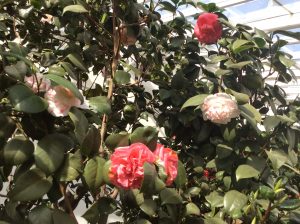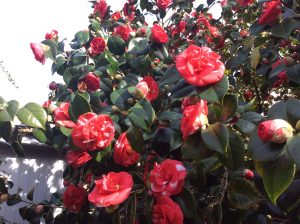March is the month of Camellias. I have three blooming in my garden.

Chiswick House has 32 in the conservatory alone – home to the oldest collection of camellias under cover in England.

Camellias come from Eastern and Southern Asia. Botanist Karl Linnaeus, who classified all our plants, named it after the missionary and botanist Georg Joseph Kamel, who worked in the Philippines and described a species of this flowering bush. There are 100-300 species of camellias, and around 3,000 hybrids, two thirds of those being Camellia Japonica, the most wide spread type grown in the UK. Abundant in gardens in Japan and China for centuries, camellia arrived in this country in the 18th century, with the efforts of plant hunters and the East India Company, – the latter provided transport and wealthy patrons, who could afford to pay for rare plants from exotic countries. A keen gardener Robert James, Lord Petrie, had camellias in his garden at Thornton Hall in Essex in 1739 – the first mention of the plant growing in this country.
Just under 100 years later, the camellia collection was established in the Chiswick House Conservatory. In 1828 the Duke of Devonshire replaced the fruit in his conservatory with the latest fashionable import – camellias from China.

The rarest plant in the Chiswick collection is Middlemist’s Red. It was brought from China by Londoner John Middlemist, who had a nursery in Shepherd’s Bush and supplied plants to Kew Gardens. This tree is one of the two currently known in the world – the other one being in Waitangi in New Zealand.

The most curious one is Pompone – On one tree flowers can be red, white, or variegated (more than one colour). This variety was brought from China to Kew in c.1810, and went by the name of Kew Bush.

Outside the conservatory bushes grow bigger, with masses of flowers – however, the get ‘bitten’ by cold air and wind at night, and go brown at the edges… this affliction affects my camellias every year….

Camellias come in a variety of flower forms – single, semi-double, double (paeony, anemone or rose form), – and colours – white, red, pink or variegated.




There’s another type of camellia that we all love – and consume – every day of the year. Camellia sinensis gives us leaves for our tea. For years I’ve been trying to grow this one, – despite being hardy enough to be grown commercially in the UK, I found it not as hardy as your big flowering bushes, but this one is not looking too bad at the moment – in my conservatory.


